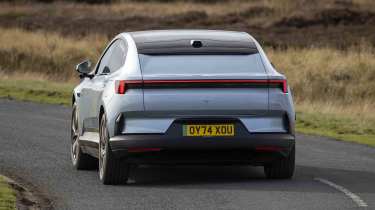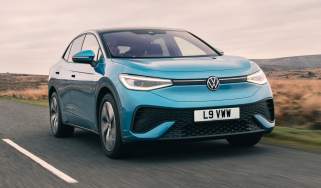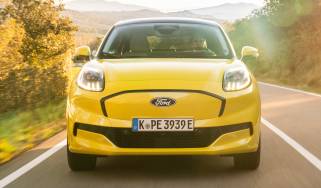Polestar 4 review – forward-looking EV with no rear window
“Stylish and accomplished in most areas, the Polestar 4 is a cool all-electric coupe-SUV for buyers looking for something different”
Pros
- Attention-grabbing design
- Competitive range figures
- Upmarket interior
Cons
- Polarising digital mirror
- Can get expensive
- Not overly engaging to drive
Verdict – is the Polestar 4 a good car?
The Polestar 4 is a somewhat niche all-electric coupe-SUV that’s aimed at discerning buyers looking for a stylish and great-driving alternative to the norm. It’s certainly unlikely to top sales charts in the same manner as the Tesla Model Y, so should get you noticed if you like your car to be a talking point. It’s decent to drive and has a competitive range too, while its controversial lack of a rear windscreen doesn’t affect things too much in daily use. It can feel rather heavy at times, though, and it’s not as engaging as its Porsche Macan Electric rival.
Polestar 4 models, specs and alternatives
This is the Polestar 4, a coupe-SUV that sits between the Polestar 2 and 3 in terms of size. If you’re wondering why it gets a higher number, unlike BMW, Polestar has chosen to name its cars in the order they are released instead of basing it on their size.
 Top 10 best electric SUVs – the ones to buy in 2025
Top 10 best electric SUVs – the ones to buy in 2025
The 4 will take on rivals like the Porsche Macan EV and Audi Q6 e-tron, along with the more mainstream Tesla Model Y and Ford Capri, and it shares its building blocks with other cars from parent company Geely like the Volvo EX30 and Smart #3. Billed as a premium and high-performance offering, it costs quite a bit more than the Polestar 2, with a starting price of around £60,000, but it undercuts the Macan Electric by around £9,000.
More reviews
In-depth reviews
Polestar isn’t bombarding customers with confusing specifications either – after you’ve chosen whether you want a single or dual motors (more on that below) there are just six paint colours to pick from and a selection of option packs to get the kit you want. The ‘Plus Pack’ gets a Harman Kardon sound system, triple-zone climate control and head-up display, while ‘Pilot Pack’ adds safety features for around £1,300. The ‘Pro Pack’ costs a bit more and brings 21-inch wheels and gold seatbelts, but it probably won’t be necessary for most buyers. Keen drivers can also splash out £4,000 on a ‘Performance Pack’ to give the car’s chassis an upgrade.
Entry-level versions of the Polestar 4 get a single motor with rear-wheel drive and 268bhp, which should be more than quick enough for the average driver. Still, if you want a real rocket, the dual-motor gets 536bhp and all-wheel drive. Both are powered by the same 94kWh battery and have an official range of more than 360 miles, while 200kW rapid charging can take capacity from 10-80% in 30 minutes.
| Trim levels | Power options |
|
|
Range, charging & running costs
Polestar has kept things nice and simple here, so as long as you can afford the Polestar 4’s fairly steep asking price or monthlies, it should prove very cheap to run. A low Benefit-in-Kind band should also help it appeal to company car choosers after something striking to impress clients.
It comes with a large-for-the-class 94kWh battery, a slippery shape (boasting a 0.26Cd drag figure) and the brand’s latest electric motor technology. This all adds up to a range figure of up to 385 miles for the Single Motor and 367 miles for the Dual Motor version, putting it just ahead of the 358 miles of the Audi SQ6 e-tron.
Polestar predicts efficiency figures of 3.4 miles/kWh for the Single Motor and 2.8 miles/kWh for the Dual Motor, and some energy-saving tricks include flush door handles, aerodynamic wheels and a rakish windscreen. The Dual Motor’s front motor can also disconnect while cruising to boost efficiency.
Charging at public DC destinations tops out at 200kW, which can take the battery from 10-80% in as little as 30 minutes in ideal conditions. It’s a competitive charging performance, but the electric Porsche Macan takes things a step further, with 270kW charging cutting top-up times to just 21 minutes.
| Model | Battery size | Range |
| Polestar 4 Long Range Single Motor | 94kWh | 385 miles |
| Polestar 4 Long Range Dual Motor | 94kWh | 367 miles |
How efficient is the Polestar 4 in the real world?
During our test drives the trip computer predicted a range of 342 miles and 369 miles for the rear-wheel and all-wheel drive cars respectively.
What will the Polestar 4 cost to insure?
The Polestar 4 isn’t likely to be a cheap car to insure, starting in group 45 (out of 50) for the single motor and group 48 for the dual motor version. Even the more affordable Tesla Model Y sits in groups starting from 46 out of 50.
Electric motor, drive & performance
Polestar is moving further away from its old ties with Volvo, and its models are clearly intended to be sportier to drive and in attitude. Even the Single Motor version gets plenty of punch with a 268bhp electric motor, although this isn’t a great deal in the age of electric SUVs from premium brands. The Polestar 4 is also rather heavy, coming in at around 2.2 tonnes, and this does have an effect on how it drives at times.
Unusually for a car in this class, the 4 doesn’t have any different driving modes, but you can individually tailor the steering weight, regenerative braking (three strengths) and turn on or off ‘Creep’, a function that allows the car to crawl forward slowly when you let off the brake like a conventional automatic.
Is it good to drive in town?
Unfortunately, the weight and large 21-inch alloy wheels fitted to our Single Motor test car made it a bit fidgety around town at lower speeds. There’s enough suspension travel to soak up bigger pot holes, though, and the ride settles as the speed picks up. The Dual Motor model has adaptive suspension as standard, and it proved to be more comfortable in its ‘Standard’ setting.
Visibility is better than you might expect, and the surround view camera setup helps thanks to a sharp image. Its steering is pretty light at low speeds, but the car’s turning circle is only average.
Is it good to drive on long journeys?
With plenty of power and no gearchanges to worry about, the Polestar 4 is a relaxed companion when accelerating in motorway traffic, and cruising along at the national speed limit. Unlike some EVs, it doesn’t feel like there’s much of a drop off in performance at higher speeds either, likely because it has such a sleek low-drag shape. Road noise isn’t too loud, but there’s some wind noise generated by the side mirrors.
Is it good to drive on B-roads?
Drive the 4 more aggressively on a winding road and its weight and raised ride height feel a bit more apparent. The front wheels aren’t especially quick to respond to the driver’s steering inputs, but there’s plenty of grip. Despite a slight hesitation when you hit the throttle pedal, the 268bhp version feels smooth and pretty quick, with a gradual increase in power that makes it easier to drive without straining your passengers neck muscles.
The Dual Motor has near-supercar levels of acceleration, it’s more responsive, and all-wheel drive helps it feel even more assured through the bends. Our test car had ‘Performance Brakes’ fitted too, and the Brembo items offered huge stopping power without feeling grabby. There are also three regenerative braking settings, from low to ‘One-pedal’ where you rarely need to touch the brake pedal.
| Model | Power | 0-62mph | Top speed |
| Polestar 4 Long Range Single Motor | 268bhp | 7.1s | 124mph |
| Polestar 4 Long Range Dual-motor | 536bhp | 3.7s | 124mph |
Carbuyer notes
“There’s also three modes to the steering wheel weight with ‘Light’, ‘Standard’ and ‘Firm’ with a good amount of differentiation between them. Firm is best for more spirited driving with some reassuring resistance to the wheel, it’s not too stiff around town either.” Alastair Crooks, Senior News Reporter
Interior & comfort
One of the Polestar 4’s most headline-grabbing features is its lack of a rear windscreen, with the car instead making use of 12 exterior cameras to ensure the driver can always see what’s happening outside. There’s a digital rear-view mirror with an 8.9-inch display, offering a 121-degree field of view and even a panning feature when you indicate (that can be turned off). It can also switch to being a standard mirror if you just want to check on back seat passengers. Some will always prefer a traditional mirror, but it works well and even does a pretty decent job of minimising headlight glare and remaining clear at night.
Volvo is well-known for its excellent seats and it appears Polestar doesn’t want to fall behind, with lots of comfort and support for front and rear occupants. Choose the Nappa Pack and it even adds Bridge of Weir leather upholstery, a massage function and headrest speakers with the Harman Kardon stereo. Materials feel upmarket throughout the interior, and the ambient lighting inspired by the colours of the solar system works well too. One quirk is that most of the controls look different to those in the Polestar 3 because of the car’s different underpinnings.
The ambient lighting has settings based on our solar system, with different colours based on the sun, moons and planets that works nicely.
Is the Polestar 4 infotainment and navigation system easy to use?
There’s a 15.4-inch display, which is landscape here instead of portrait in the Polestar 2. It uses a Google-based setup that’s mostly intuitive and slick, and while our early test car’s responses stuttered occasionally, we’re told this won’t be the case in customer cars. A few too many functions are also buried within submenus.
Physical buttons have mostly been banished, and while we’d prefer them for the climate control, the steering wheel does at least get physical rather than capacitive buttons.
Is the Polestar 4 well equipped?
The Polestar 4 isn’t a cheap car in any guise, so even as standard it comes with a luxurious specification. The Plus Pack comes included with UK cars, so the roster includes a 15.4-inch touchscreen, 10.2-inch driver’s display, a panoramic roof, a Harman Kardon stereo, head-up display, triple-zone climate control and a powered tailgate, along with pixel LED headlights.
What options should you choose on the Polestar 4?
It’s rather important to pick Polestar 4 options wisely, because the packs on offer can make quite a big difference above the choice of six colours. The Pilot Pack (£1,300) nets you extra safety features, while the £1,800 Pro Pack ushers in 21-inch alloy wheels and gold seatbelts, so unless you love how they look, you probably won’t need to splash out on it. Then there’s the pricey £4,000 Performance Pack that makes the chassis sportier, so it won’t be on the radar of most family or business buyers.
Key features | |
|
Polestar 4
|
Pilot Pack (Polestar 4 plus…)
|
|
Pro Pack (Polestar 4 plus…)
|
Performance Pack (dual motor only) (Polestar 4 plus…)
|
Practicality & boot space
As we’ve mentioned above, one of the most novel features of the Polestar 4 is its lack of a rear windscreen. One reason for this was to allow designers to give the coupe-SUV a swooping roofline, while still maintaining enough rear passenger space for taller occupants. In fact, the Polestar 4 actually has slightly more length between its front and rear wheels than the 3 SUV, and it’s a touch wider, so interior space is plentiful.
Worries that the back seats might be rather claustrophobic have also been avoided. The panoramic roof stretches back further than normal, and the side windows also extend back behind your head, so it still feels quite airy. The rear seats are also nicely reclined to add comfort over longer trips.
Various cubbies are dotted around the cabin, but most of these aren’t overly large, with the 15-litre centre console being amongst the biggest. The rear armrest has cupholders, but doesn’t get a folding table or tablet holder like the bigger Polestar 3.
| Size comparison | |||
| Model | Length | Width | Height |
| Polestar 4 | 4,840mm | 2,139mm | 1,534mm |
| Porsche Macan Electric | 4,784mm | 1,936mm | 1,622mm |
| Audi Q6 e-tron | 4,771mm | 1,939mm | 1,702mm |
| Tesla Model Y | 4,751mm | 1,921mm | 1,600mm |
Does the Polestar 4 have a big boot?
If you need to upgrade from a Polestar 2 – or any other small executive EV for that matter – the 526-litre boot on offer in the Polestar 4 is likely to represent a decent upgrade in space. It falls short of being class-leading, though, with the Porsche Macan EV offering 540 litres and the Tesla Model Y’s boot being larger again. The sloping rear roofline and a fairly high loading lip also means the Polestar 4 loses a few points for outright practicality. While it’s handy for keeping a charging cable accessible, the 15-litre front storage area is much smaller than the Model Y’s 117-litre frunk.
| Boot space comparison | |
| Model | Boot space |
| Polestar 4 | 526 litres |
| Porsche Macan Electric | 540 litres |
| Audi Q6 e-tron | 526 litres |
| Tesla Model Y | 854 litres |
Is the Polestar 4 a good tow car?
While EVs don’t always make the best tow cars – and pulling a trailer can put a dent in the car’s range figure – the Polestar 4 can at least haul an impressive 2,000kg.
Reliability & safety
Polestar is still a relatively small brand, and it didn’t feature in our most recent Driver Power survey, despite an impressive second-place finish in 2023. Polestar is also part of the family of Geely brands that also includes Volvo, Lotus and Smart, so there’s serious resource and know-how behind its engineering and manufacturing.
For instance, the Polestar 4 uses the same basic building blocks as the Volvo EX30 and Smart #3, both of which are tipped to sell in fairly high volumes. Even if there are any reliability issues, we’d hope they are found and tackled quickly.
How safe is the Polestar 4?
When Polestar grew out of Volvo, the same safety know-how and technology appears to have been carried over and continued to evolve. It’s kitted out with a serious amount of safety features, starting with seven airbags. A total of 12 cameras, one radar sensor and 12 ultrasonic sensors mean a collision should be a pretty rare occurrence, however.
Inside the cabin there’s a driver-monitoring camera to ensure the driver isn’t fatigued or distracted, while a head-up display means key information is projected ahead of the driver. The latter even has a ‘snow mode’ which changes the text from white to yellow in snowy environments. An optional Pilot Pack can also help with changing lanes, initiated by a tap on the indicator stalk.
What are the Polestar 4 service intervals?
Polestar will cover the first three years or 31,250 miles of servicing for free, whichever comes first. Thanks to its links with Volvo, it’s likely you’ll have a service centre nearby even if it isn’t an exclusive Polestar dealership. Polestar can also offer a pick-up and delivery service from your home at work and provide alternative transport during maintenance.
What is the warranty on the Polestar 4?
The Polestar 4 comes with a three year/60,000-mile warranty from the factory, whichever comes first. This is about the minimum for a new car, and while it’s comparable with the likes of Ford and Volkswagen, manufacturers including Hyundai, Kia and Toyota all offer cover that lasts considerably longer.
Should you buy a Polestar 4?
Polestar feels an awful lot like the modern-day equivalent of now-defunct brand Saab, because while cars from that Swedish brand didn’t necessarily offer better performance or features than rivals, its cars had a style and fanbase all of their own.
The Polestar is by no means a bad car on paper, with competitive power outputs, driving range figures and kit, but you might be wondering why you’d pick one over a Porsche, Tesla or an Audi? In reality, the answer for most customers is likely to be because they want something a bit different to the norm. Perhaps even a car with no rear window?
It isn’t without its faults, the Polestar 4; not everyone will like its digital rear-view mirror or the fact it weighs over 2.2 tonnes and can feel somewhat inert to drive as a result. But cruising along in its well-appointed interior, listening to its Harman Kardon stereo and catching a glimpse of your Polestar 4’s reflection in a shop window, that’s hardly likely to matter too much. Amongst a sea of rather similar-looking new cars, the Polestar 4 feels like a breath of fresh air.
What is the best Polestar 4 for families?
Our top pick for families is the Polestar 4 Long Range Single Motor in its standard guise, with no option packs added. This is still hardly a bare-bones prospect, with 268bhp and the best range on offer of 385 miles between charges. It also gets plenty of the kit most people need, without adding styling and performance upgrades.
What is the best Polestar 4 for keen drivers?
While the standard version is hardly slow, for serious performance chops you’ll want the Dual Motor Polestar 4 with a whacking 536bhp. This whisks you and your passengers from 0-62mph in as little as 3.7 seconds. This gets adaptive suspension as standard, but keen drivers will also want to pick the ‘Performance Pack’, which beefs up the chassis and has recalibrated settings for improved handling. It also adds Brembo brakes and gold accents for the brakes, valve caps and seat belts.
What is the Carbuyer pick of the range?
We’d stick with the same thinking as for our top choice for families, because the entry-level Polestar 4 will be plenty quick enough for most drivers and have all the equipment they’ll ever need. For long-distance drivers spending lots of time in their car, however, it’s hard to deny the appeal of the Nappa upgrade with Bridge of Weir leather upholstery, a massage function, ventilation and headrest speakers.
Polestar 4 alternatives
With hardly any coupes now left on sale, buyers have shifted to coupe-SUVs, and the Polestar 4 slots into a new breed of sleek electric crossovers on steroids. These can appeal to families, business drivers and enthusiasts in equal measure.
- Porsche Macan Electric
- Audi Q6 e-tron
- Tesla Model Y
- Ford Capri
- Jaguar I-Pace
- Maserati Grecale Folgore
How we tested the Polestar 4
We first tested the Polestar 4 in June 2024 at its launch event in Spain, taking in both smooth winding roads and the sort of poor road surfaces more common in Britain. We also tested the Polestar 4 in the UK later in 2024.

























